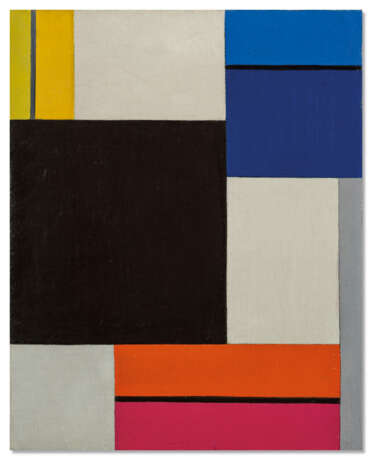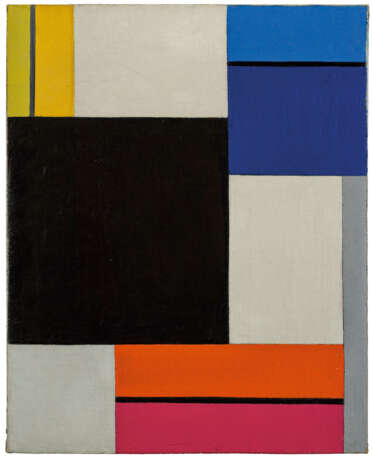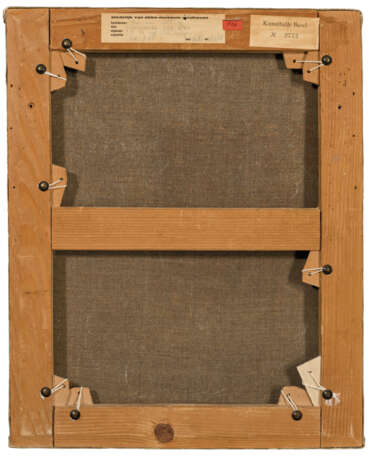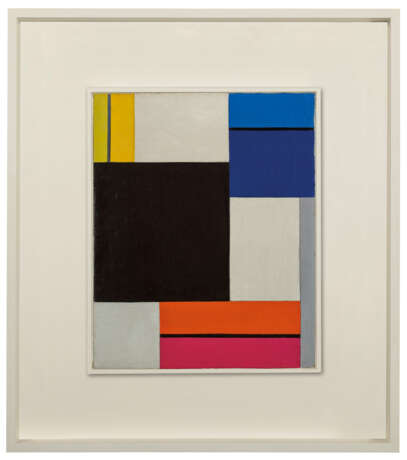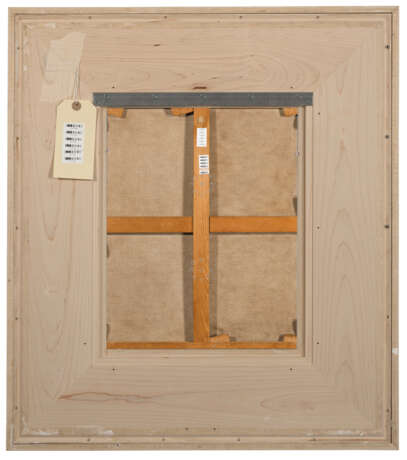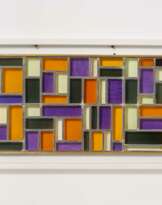ID 832058
Los 18 | Theo Van Doesburg (1883-1931)
Schätzwert
€ 1 400 000 – 2 000 000
Composition XXI
huile sur toile
41.2 x 33 cm.
Peint en juin-juillet 1923
oil on canvas
16 1/4 x 13 in.
Painted in June-July 1923
Provenance
Bart de Ligt (1883 –1938), Driebergen et Ronco sopra Ascona (acquis auprès de l'artiste, probablement fin 1923).
Puis par descendance au propriétaire actuel.
Literature
T. van Doesburg, List 1, 1916-1926, (titré ‘Compositie XXIV … 1923 Paris (in dissonant black square) KOK’).
Portfolio de l'artiste, no. 152 (titré 'Composition au plan noir XXII' et daté '1920/23').
Lettres de Theo van Doesburg à Antony Kok, 1923.
S. Polano, éd., Theo van Doesburg, Scritti di arte e di architettura, Rome, 1979, p. 530, no. 152 (titré ‘Composizione XXI con piano nero’ et daté ‘1920’).
C. Blotkamp, H. Esser et S. Ex, De Begin jaren van De Stijl, 1917-1922, Utrecht, 1982 , p.37-38 (illustré, p. 37, fig. 25; daté '1920-21').
C. Blotkamp, éd., De Vervolgjaren van De Stijl, 1922-1932, Amsterdam, 1996, p. 35 (illustré in situ à Paris en 1923).
E. Hoek, éd., Theo van Doesburg, Œuvre catalogue, Utrecht et Otterlo, 2000, p. 330, no. 690 (illustré en couleurs, p. 331).
A. Ottevanger, éd., 'De Stijl overal absolute leiding', De briefwisseling tussen Theo van Doesburg en Antony Kok, Bussum, 2008, p. 426, 431, 435, 448 et 451.
S. van Faassen et H. Renders, Ik sta helemaal alleen, Theo van Doesburg, Amsterdam, 2022.
Exhibited
Bâle, Kunsthalle, Konstruktivisten, janvier-février 1937, p. 11, probablement no. 3, 4, 5, 13 ou 14 (titré 'Composition'; et daté '1920').
Eindhoven, Stedelijk van Abbemuseum; La Haye, Gemeentemuseum et Bâle, Kunsthalle, Theo van Doesburg, décembre 1968- juillet 1969, no. A28 (titré ‘Compositie XXII’ et daté ‘1920’).
Nuremberg, Kunsthalle et Bâle, Kunsthalle, Theo van Doesburg, Konstruktive Kunst, Elemente und Prinzipien, avril-septembre 1969, no. A24 (daté ‘1920’).
Bruxelles, BOZAR, Theo van Doesburg, A New Expression of Life, Art and Technology, février-mai 2016, p. 169, no. 90 (illustré en couleurs).
Post lot text
« Mondrian reconnaît l'importance du trait. Le trait est quasiment devenu une œuvre d'art en lui-même ; on ne peut pas en jouer lorsque la représentation des objets perçus prédomine. La toile blanche est presque solennelle. La moindre ligne superflue, la moindre ligne mal placée, n'importe quelle couleur appliquée avec négligence peut tout gâcher – c'est-à-dire, la dimension spirituelle. »
Theo van Doesburg dans son journal, 6 novembre 1915.
“Mondrian realizes the importance of line. The line has almost become a work of art in itself; one cannot play with it when the representation of objects perceived was all-important. The white canvas is almost solemn. Each superfluous line, each wrongly placed line, any colour placed without veneration or care, can spoil everything—that is, the spiritual.”
Theo van Doesburg in his diary, 6 November 1915.
« J'ai achevé ces deux petits tableaux juste après mon rhume des foins. Le tien est devenu sublime. J'ai rendu le rouge du bas un peu plus clair, complètement repris le bleu. »
(Lettre de Theo van Doesburg à Antony Kok, dernière semaine de juillet 1923, cité in A. Ottevanger, ed., Op. cit., 2008, p. 431.)
“I finished those little paintings right after my hay fever. Yours has now become sublime. I made the bottom red a little lighter, the blue all over again.”
(Letter from Theo van Doesburg to Antony Kok, final week of July 1923, quoted in A. Ottevanger, ed., Op. cit., 2008, p. 431.)
Œuvre majeure de Theo van Doesburg conçue en 1923, Composition XXI reflète non seulement la complexité grandissante du style épuré de l'artiste à cette époque, mais aussi le rapport fondamental entre peinture et architecture qui sous-tend l'ensemble de sa vision plastique. Il souligne lui-même l'importance de ce tableau pour son développement artistique dans un article paru le 17 juillet 1923 dans la revue Architectura, où il expose en détail les idées qui ont mené à sa conception. Van Doesburg avait joué un rôle déterminant dans la fondation du groupe De Stijl en 1917, un cercle d'artistes et d'architectes néerlandais unis par un projet commun : celui de promouvoir une révolution esthétique et culturelle qui mènerait à une communion inédite entre l'art et la vie, afin de contrecarrer la destruction et la violence absurdes de la guerre. Leurs œuvres – d'une abstraction rigoureuse, tout en formes géométriques pures et en couleurs primaires – étaient nourries par la croyance que la fusion des beaux-arts, de l'architecture et des arts décoratifs pouvait conduire à cette nouvelle utopie sociale. Ensemble, ils « redéfinirent non seulement le vocabulaire et la grammaire des arts visuels, écrit Hans L. C. Jaffé, mais dotèrent aussi la peinture, l'architecture et les autres arts d'une nouvelle vocation : celle de guider l'humanité, de la préparer à l'harmonie et à l'équilibre de la 'nouvelle vie' à venir, de servir le genre humain en l'éclairant » (H.L.C. Jaffé, De Stijl, Visions of Utopia, cat. exp., Minneapolis, 1982, p. 15). Van Doesburg s'imposa très vite comme le principal porte-parole du groupe. Déterminé à diffuser les idéaux du mouvement auprès de l'avant-garde internationale, il quitta les Pays-Bas en 1921 pour entreprendre un long voyage à travers les grandes villes d'Europe, donnant sur son passage de nombreuses conférences et montant des expositions du Stijl.
Avec sa structure quadrillée typiquement « néoplastique » et ses formes de couleur pure, la présente œuvre, exécutée à Paris à l'été 1923, témoigne des dernières heures d'amitié entre van Doesburg et son compatriote et camarade peintre Piet Mondrian. Au lendemain de leur rencontre en 1915, les deux artistes s'étaient en effet rapprochés et, au fil d'une longue relation épistolaire, Mondrian était devenu le conseiller artistique le plus précieux de van Doesburg.
En 1923, van Doesburg et son épouse Nelly van Moorsel décident de s'installer à Paris, où vit alors Mondrian. Après quelques mois seulement sous les mêmes cieux, les deux peintres finissent toutefois par se brouiller durablement ; leur réconciliation ne surviendra qu'en 1929. Le présent tableau est l'une des rares reliques de la peinture que produit van Doesburg à Paris avant la dégradation de cette importante relation. Elle atteste l'un de ses derniers échanges stimulants avec Mondrian.
Comme nombre de ses toiles du début des années 1920, la palette, la composition des motifs et la disposition des formes de Composition XXI puisent leur source dans l'intérêt marqué de van Doesburg pour l'architecture – domaine dans lequel il travaille par ailleurs activement. Les croquis et dessins qu'il réalise en 1923 pour l'aménagement intérieur de l'université de Cornelis van Eesteren trouvent notamment un écho évident dans la présente composition. Ses plans pour ce projet synthétisent parfaitement les aspirations de van Doesburg pour l'art, l'architecture et le design du futur : « La nouvelle architecture emploie la couleur de manière organique, comme un moyen d'expression direct des rapports dans l'espace et le temps […] Le rôle du peintre moderne consiste à intégrer la couleur dans l'harmonie du grand tout (en l'appliquant non pas sur une surface plane en deux dimensions, mais dans le champ de l'espace-temps en quatre dimensions) » (cité in N. J. Troy, « The Abstract Environment of De Stijl », in H.L.C. Jaffé, op. cit., 1982, pp. 184-185). Le résultat procure une sensation de flottement ; les plans de couleurs semblent suspendus dans l'espace, leurs formes existant comme des entités concrètes et totalement autonomes. Un concept architectural que van Doesburg parvient à traduire à la peinture dans Composition XXI : se servant du carré noir au centre de la toile, l'artiste crée une sensation de mouvement et de dynamisme qui vient délier les aplats de couleur alentour. Ceux-si semblent ainsi planer librement au sein de la composition. Van Doesburg avait une vision très précise du résultat qu'il voulait obtenir dans ce tableau. Dans une lettre au commanditaire de l'œuvre, l'écrivain et artiste Antony Kok, le peintre décrit la manière dont il a ajusté les nuances de sa palette afin d'atteindre un état transcendantal : « J'ai achevé ces deux petits tableaux juste après mon rhume des foins. Le tien est devenu sublime. J'ai rendu le rouge du bas un peu plus clair, complètement repris le bleu » (lettre de Theo van Doesburg à Antony Kok, dernière semaine de juillet 1923, cité in A. Ottevanger, ed., op. cit., 2008, p. 431).
Bien que Composition XXI fut réalisée à la demande d'Antony Kok (1882-1969), son premier propriétaire ne fut autre que le militant antimilitariste, anarchiste et pacifiste néerlandais Bart de Ligt (1883-1938). En effet, les lettres conservées dans les archives de van Doesburg révèlent que Bart de Ligt a récupéré Composition XXI pour le compte de Kok dans l'atelier de l'artiste à Paris en 1923. Cependant, à la fin de la même année, étant tombé sous le charme de cette œuvre, de Ligt demanda à van Doesburg et à Kok s'il pouvait l'acheter lui. Kok ayant déjà payé l’œuvre, un arrangement fut trouvé et Kok accepta que van Doesburg lui peigne une autre œuvre pour remplacer celle qui lui était initialement destiné. Van Doesburg, écrit à ce propos à Kok, dans une lettre de janvier 1924, qu’il lui " doit encore un tableau" (Lettre de Theo van Doesburg à Antony Kok, 11 janvier 1924, citée dans ibid., p. 451).
Bart de Ligt, qui avait été pasteur protestant jusqu'en 1915, avait rejoint dès le début de la Grande Guerre des cercles antimilitaristes. Devenu anarchiste et libre-penseur, il avait fini par rompre avec le socialisme chrétien pour défendre ouvertement une forme d'insoumission non violente dont il exposa notamment les principes au congrès de l'Internationale des Résistants à la Guerre, puis dans un essai intitulé Pour vaincre sans violence : réflexions sur la guerre et la révolution, d'abord paru en néerlandais en 1934, puis en français et enfin en anglais en 1936. À ce moment-là, il était déjà l'auteur de plusieurs ouvrages, dont Contre la guerre nouvelle (1928), La Paix créatrice : histoire des principes et des tactiques de l'action directe contre la guerre (1933), Clara Meijer Wichmann als verdedigster der menschelijkheid (1933) (« Clara Meijer Wichmann, en défenseure de l'Humanité ») et Mobilisation contre toute guerre ! (1934). De Ligt entretenait en outre des échanges fréquents avec Mahatma Gandhi au sujet de la résistance pacifiste. Inspiré par la vision du Néerlandais et leur correspondance écrite (qui a été conservée et publiée), Gandhi adapta certaines de ses idées par la suite.
Van Doesburg rencontra très probablement Bart de Ligt pour la première fois à l'automne 1918 : celui-ci donnait alors à Leyde un cours sur le développement de la vie spirituelle à lumière des récits bibliques, dont van Doesburg était un auditeur assidu et particulièrement critique. De Ligt s'était, quant à lui, pris d'admiration pour les motifs de couleurs dont van Doesburg avait habillé l'intérieur de la résidence de vacances De Vonk à Noordwijkerhout. À cette époque, la maison de campagne de de Ligt à Katwijk aan Zee (Pays-Bas) était en cours de rénovation. Aussi, celui-ci demanda-t-il à son architecte, Van 't Hoff, de se procurer le mobilier auprès du designer du Stijl Gerrit Rietveld (1888-1964) et d'inviter van Doesburg à participer à la décoration d'intérieur. S'il ne reste aujourd'hui ni archives, ni photographies de ce projet, hormis une étude, il semblerait que van Doesburg travailla sur six pièces différentes, et acheva la commande en 1919, à la suite de quoi il maintint son amitié avec de Ligt. Theo van Doesburg et Antony Kok ont également sympathisé avec de Ligt et ses entreprises idéalistes. L'artiste et Kok devinrent d'ailleurs tous deux membres de l'Union des Intellectuels Socialistes Révolutionnaires fondée par de Ligt en octobre 1919 – preuve, s'il en fallait, du rôle déterminant que de Ligt joua dans le développement de la conscience et de la connaissance politique de l'artiste. En outre, de Ligt était également un important mécène de l'art d'avant-garde, promouvant Van Doesburg mais aussi Mondrian, dont il possédait un tableau intitulé Composition avec jaune, noir, bleu, rouge et gris de 1922, qui fait aujourd'hui partie des collections du musée d'Orsay (actuellement en prêt au musée Granet à Aix-en-Provence).
Transmise de génération en génération, Composition XXI de van Doesburg, est restée entre les murs de la même famille depuis 1923 ; soit près d'un siècle durant lequel son éclat et son intégrité ont été judicieusement préservés, la laissant intacte pour sa mise en vente aujourd'hui. La provenance exceptionnelle de ce tableau témoigne d’une amitié forte, d’une admiration mutuelle et d’une vision commune de l'art, partagées par de Ligt et van Doesburg.
Dating from 1923, Composition XXI is a key work within Theo van Doesburg’s oeuvre, which illustrates not only the growing complexity of the artist’s iconic, purist style of painting at this time, but also the essential link between architecture and art that underpinned his unique creative vision. Van Doesburg himself described this painting as significant in his development as an artist, hence his own description of the concept of its creation in the architecture magazine Architectura on 17th July 1923. Van Doesburg had been an instrumental figure in the founding of De Stijl, a group of likeminded Dutch artists and architects who gathered together in 1917 to advocate for an aesthetic and cultural revolution, one which would result in a new unity between life and art that could counteract the senseless destruction and violence of war. Their works were driven by the belief that the synthesis of art, architecture and design offered a path to this new social utopia, and featured a common focus on pure geometric shapes, stark abstraction and primary colours. Together they ‘not only redefined the vocabulary and the grammar of the visual arts,’ Hans L. C. Jaffé has written, ‘they assigned a new task to painting, architecture and the other arts: to serve as a guide for humanity to prepare it for the harmony and balance of the “new life,” to serve mankind by enlightening it’ (H.L.C. Jaffé, De Stijl, Visions of Utopia, exh. cat., Minneapolis, 1982, p. 15). Van Doesburg quickly emerged as the central spokesman for the group and, determined to propagate the ideals of De Stijl amongst the international avant-garde, he left Holland in 1921 on a grand voyage of Europe, visiting cities across the continent, delivering lectures and organising exhibitions of their work.
Executed in Paris in the summer of 1923, the pure colour forms and neoplasticist grid structure of the present work testifies to the final days of friendship between van Doesburg and fellow Dutch painter Piet Mondrian. Mondrian would become van Doesburg’s most important artistic mentor, with the two painters striking up an epistolary friendship following their introduction in 1915.
In 1923, van Doesburg and his wife Nelly van Moorsel decided to move to Paris, Mondrian’s hometown. After only a few months of living in the same city, however, the two artists had a falling out that would last until 1929. The present painting is a rare relic of van Doesburg’s Parisian works before the souring of this important relationship, and it bears witness one of the last stimulating dialogues between van Doesburg and Mondrian.
As with many of Van Doesburg’s paintings from the early 1920s, the colour palette, compositional patterns and arrangement of forms in Composition XXI are rooted in the artist’s interest and engagement with architecture. Particularly pertinent to the present composition were the drawings and sketches Van Doesburg created in 1923 for the interior designs of Cornelis van Eesteren’s University Building. The designs embodied Van Doesburg’s vision for the future of art, architecture and design: ‘The new architecture employs colour organically as a direct means of expression of relationships in space and time … The task of the modern painter is to integrate colour into a harmonic whole (by placing it not on a plane surface of two dimensions, but within the new realm of four-dimensional space-time)’ (quoted in N. J. Troy, ‘The Abstract Environment of De Stijl’, in H.L.C. Jaffé, op. cit., 1982, p. 184-185). The result was a sensation that the planes of colour were suspended freely within the space, their forms existing as distinct entities in their own right. It is a concept that van Doesburg successfully translated into pictorial form in Composition XXI, using the black central shape to suggest a sense of movement and dynamism, setting the colour planes free and creating the impression they are floating within the composition. Van Doesburg’s vision for the present painting was exacting. In a letter to artist and writer Antony Kok, who had commissioned the work, van Doesburg details how he adjusted the shade of the colours to attain a transcendental state: “I finished those little paintings right after my hay fever. Yours has now become sublime. I made the bottom red a little lighter, the blue all over again.” (Letter from Theo van Doesburg to Antony Kok, final week of July 1923, quoted in A. Ottevanger, ed., op. cit., 2008, p. 431.)
Although Antony Kok commissioned Composition XXI, its first owner was actually Bart de Ligt (1883-1938), the Dutch anarchopacifist and antimilitarist, who was a great admirer of Theo van Doesburg. Indeed, the van Doesburg archive of letters reveal that Bart de Ligt collected Composition XXI on behalf of Kok from the artist’s studio in Paris in 1923. By late 1923, however, de Ligt had become so fond of the work that he asked van Doesburg and Kok if he could purchase it for himself. Kok had already paid for the painting but agreed for the artist to produce another work for him to replace it, as recorded in a letter of January 1924, in which the artist writes to Kok to inform him that he was still “owed a painting” (Letter from Theo van Doesburg to Antony Kok, 11 January 1924, quoted in ibid., p. 451).
Bart de Ligt was a practicing pastor until 1915 and was part of antimilitarist circles since the outbreak of World War I, having become an anarchist and freethinker after detaching himself from Christian socialism. He advocated a non-violent resistance, outlined at the congress of the War Resisters' International, which he published in his book titled The Conquest of Violence; and Essay on War and Revolution first in Dutch in 1934, then in French and finally in English in 1936. By that time, de Ligt had written several books, including A World Crisis and Philosophy(1928), A Global Issue (1930), Peace as an Act, Principles, History and Methods of Combat of Direct Action against War (1933), and Clara Meijer Wichmann as Defender of Humanity (1933). Bart de Ligt was also in regular contact with Mahatma Gandhi with regards to the concept of peaceful resistance, which Gandhi eventually adapted to a large extent, being inspired by de Ligt’s ideas and their mutual correspondence, which has been preserved and published. Van Doesburg’s first encounter with Bart de Ligt (1883-1938) most probably dates back to the autumn of 1918, when de Ligt taught in Leiden a course on the development of religious life as reflected in the Bible, from which Van Doesburg had distinguished himself as a remarkably critical listener. Bart de Ligt had discovered and much admired Van Doesburg's colour designs at the De Vonk holiday residence in Noordwijkerhout. At that time, he was having his country house in Katwijk-aan-See (Netherlands) renovated by interior designer Van ‘t Hoff, to whom he asked for the furniture to be provided by De Stijl designer Gerrit Rietveld (1888-1964) and for Van Doesburg’s participation to the decoration. Although no documents or photos of Van Doesburg’s work on de Ligt’s house have survived apart from one study, it seems that Van Doesburg worked on at least six rooms and probably completed the commission in 1919. Even after completing his work for de Ligt, Van Doesburg remained close friends with the latter. Theo van Doesburg and Antony Kok also sympathised with de Ligt and his idealistic undertakings. Consequently, both the artist and Kok became members of the Union of Revolutionary Socialist Intellectuals (RRSI), which de Ligt founded in October 1919. There is no doubt that de Ligt not only played a seminal role for Van Doesburg in introducing him to politics and becoming knowledgeable in the subject, but he was also an important patron of avant-garde art, promoting Van Doesburg but also Mondrian, as he owned one of the latter’s paintings titled Composition with Yellow, Black, Blue, Red, and Grey of 1922, today part of the Musée d’Orsay collections but currently on a long-term loan to the Musée Granet in Aix-en-Provence.
Having been passed down through the generations, Composition XXI by Theo van Doesburg has remained in the same family since 1923, almost a hundred years, where it has been exhibited very judiciously, carefully preserving this exquisite work’s freshness and integrity for the market. The exceptional provenance of this painting encapsulates a rich cultural inheritance, that bears witness to a period characterised by friends mutually inspiring and admiring one another, in addition to sharing a common vision on art, design and world philosophy.
| Künstler: | Theo van Doesburg (1883 - 1931) |
|---|---|
| Angewandte Technik: | Öl auf Leinwand |
| Kategorie des Auktionshauses: | Gemälde |
| Künstler: | Theo van Doesburg (1883 - 1931) |
|---|---|
| Angewandte Technik: | Öl auf Leinwand |
| Kategorie des Auktionshauses: | Gemälde |
| Adresse der Versteigerung |
CHRISTIE'S 8 King Street, St. James's SW1Y 6QT London Vereinigtes Königreich | |
|---|---|---|
| Vorschau |
| |
| Telefon | +44 (0)20 7839 9060 | |
| Aufgeld | see on Website | |
| Nutzungsbedingungen | Nutzungsbedingungen |
